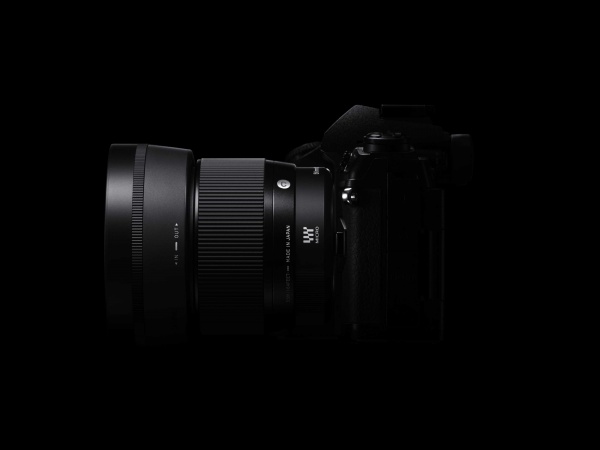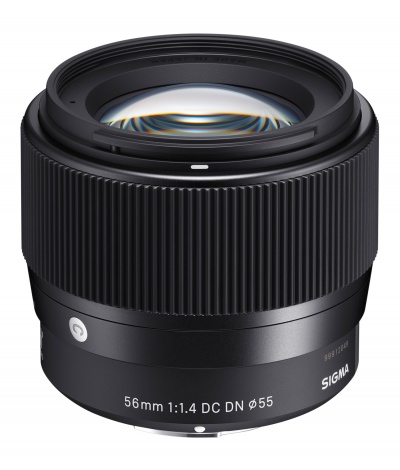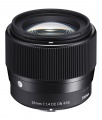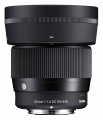Sigma 56mm F1.4 DC DN Contemporary: Unterschied zwischen den Versionen
K (Änderungen wg. OM-1 digital durchgeführt) |
K (Techn. Daten akt.) |
||
| Zeile 25: | Zeile 25: | ||
{| | {| | ||
|bgcolor="#D1E8FF" align="center" rowspan="2"|'''Kompatible [[Objektiv]]e''' | |bgcolor="#D1E8FF" align="center" rowspan="2"|'''Kompatible [[Objektiv]]e''' | ||
| − | |bgcolor="#D1E8FF" align="center" colspan=" | + | |bgcolor="#D1E8FF" align="center" colspan="11"|'''Kompatible [[Kamera]]s''' |
|- | |- | ||
|bgcolor="#D1E8FF" align="left"|[[OM-1 (digital)]] | |bgcolor="#D1E8FF" align="left"|[[OM-1 (digital)]] | ||
| Zeile 35: | Zeile 35: | ||
|bgcolor="#D1E8FF" align="left"|[[OM-D E-M5 III]] | |bgcolor="#D1E8FF" align="left"|[[OM-D E-M5 III]] | ||
|bgcolor="#D1E8FF" align="left"|[[OM-D E-M10 II]] | |bgcolor="#D1E8FF" align="left"|[[OM-D E-M10 II]] | ||
| + | |bgcolor="#D1E8FF" align="left"|[[OM-D E-M10 III]] | ||
| + | |bgcolor="#D1E8FF" align="left"|[[OM-D E-M10 IV]] | ||
|bgcolor="#D1E8FF" align="left"|[[PEN F (digital)|PEN F]] | |bgcolor="#D1E8FF" align="left"|[[PEN F (digital)|PEN F]] | ||
|- | |- | ||
| Zeile 46: | Zeile 48: | ||
|bgcolor="#D1E8FF" align="center"|x | |bgcolor="#D1E8FF" align="center"|x | ||
|bgcolor="#D1E8FF" align="center"| | |bgcolor="#D1E8FF" align="center"| | ||
| + | |bgcolor="#D1E8FF" align="center"| | ||
| + | |bgcolor="#D1E8FF" align="center"|x | ||
|bgcolor="#D1E8FF" align="center"| | |bgcolor="#D1E8FF" align="center"| | ||
|- | |- | ||
| Zeile 57: | Zeile 61: | ||
|bgcolor="#D1E8FF" align="center"|x | |bgcolor="#D1E8FF" align="center"|x | ||
|bgcolor="#D1E8FF" align="center"| | |bgcolor="#D1E8FF" align="center"| | ||
| + | |bgcolor="#D1E8FF" align="center"| | ||
| + | |bgcolor="#D1E8FF" align="center"|x | ||
|bgcolor="#D1E8FF" align="center"| | |bgcolor="#D1E8FF" align="center"| | ||
|- | |- | ||
| Zeile 68: | Zeile 74: | ||
|bgcolor="#D1E8FF" align="center"|x | |bgcolor="#D1E8FF" align="center"|x | ||
|bgcolor="#D1E8FF" align="center"| | |bgcolor="#D1E8FF" align="center"| | ||
| + | |bgcolor="#D1E8FF" align="center"| | ||
| + | |bgcolor="#D1E8FF" align="center"|x | ||
|bgcolor="#D1E8FF" align="center"| | |bgcolor="#D1E8FF" align="center"| | ||
|- | |- | ||
| Zeile 79: | Zeile 87: | ||
|bgcolor="#D1E8FF" align="center"|x | |bgcolor="#D1E8FF" align="center"|x | ||
|bgcolor="#D1E8FF" align="center"| | |bgcolor="#D1E8FF" align="center"| | ||
| + | |bgcolor="#D1E8FF" align="center"| | ||
| + | |bgcolor="#D1E8FF" align="center"|x | ||
|bgcolor="#D1E8FF" align="center"| | |bgcolor="#D1E8FF" align="center"| | ||
|- | |- | ||
| Zeile 90: | Zeile 100: | ||
|bgcolor="#D1E8FF" align="center"|x | |bgcolor="#D1E8FF" align="center"|x | ||
|bgcolor="#D1E8FF" align="center"| | |bgcolor="#D1E8FF" align="center"| | ||
| + | |bgcolor="#D1E8FF" align="center"| | ||
| + | |bgcolor="#D1E8FF" align="center"|x | ||
|bgcolor="#D1E8FF" align="center"| | |bgcolor="#D1E8FF" align="center"| | ||
|- | |- | ||
| Zeile 101: | Zeile 113: | ||
|bgcolor="#D1E8FF" align="center"|x | |bgcolor="#D1E8FF" align="center"|x | ||
|bgcolor="#D1E8FF" align="center"| | |bgcolor="#D1E8FF" align="center"| | ||
| + | |bgcolor="#D1E8FF" align="center"| | ||
| + | |bgcolor="#D1E8FF" align="center"|x | ||
|bgcolor="#D1E8FF" align="center"| | |bgcolor="#D1E8FF" align="center"| | ||
|- | |- | ||
| Zeile 112: | Zeile 126: | ||
|bgcolor="#D1E8FF" align="center"|x | |bgcolor="#D1E8FF" align="center"|x | ||
|bgcolor="#D1E8FF" align="center"| | |bgcolor="#D1E8FF" align="center"| | ||
| + | |bgcolor="#D1E8FF" align="center"| | ||
| + | |bgcolor="#D1E8FF" align="center"|x | ||
|bgcolor="#D1E8FF" align="center"| | |bgcolor="#D1E8FF" align="center"| | ||
|- | |- | ||
| Zeile 123: | Zeile 139: | ||
|bgcolor="#D1E8FF" align="center"|x | |bgcolor="#D1E8FF" align="center"|x | ||
|bgcolor="#D1E8FF" align="center"|x | |bgcolor="#D1E8FF" align="center"|x | ||
| + | |bgcolor="#D1E8FF" align="center"| | ||
|bgcolor="#D1E8FF" align="center"|x | |bgcolor="#D1E8FF" align="center"|x | ||
| + | |bgcolor="#D1E8FF" align="center"| | ||
|- | |- | ||
|bgcolor="#D1E8FF" align="left"|[[M.ZUIKO DIGITAL ED 40-150mm F4.0 PRO|Olympus M.ZUIKO DIGITAL ED 40-150mm F4.0 PRO]] | |bgcolor="#D1E8FF" align="left"|[[M.ZUIKO DIGITAL ED 40-150mm F4.0 PRO|Olympus M.ZUIKO DIGITAL ED 40-150mm F4.0 PRO]] | ||
|bgcolor="#D1E8FF" align="center"|x | |bgcolor="#D1E8FF" align="center"|x | ||
| − | |bgcolor="#D1E8FF" align="center"| | + | |bgcolor="#D1E8FF" align="center"| |
| − | |||
| − | |||
|bgcolor="#D1E8FF" align="center"|x | |bgcolor="#D1E8FF" align="center"|x | ||
|bgcolor="#D1E8FF" align="center"|x | |bgcolor="#D1E8FF" align="center"|x | ||
|bgcolor="#D1E8FF" align="center"|x | |bgcolor="#D1E8FF" align="center"|x | ||
| + | |bgcolor="#D1E8FF" align="center"| | ||
|bgcolor="#D1E8FF" align="center"|x | |bgcolor="#D1E8FF" align="center"|x | ||
| + | |bgcolor="#D1E8FF" align="center"| | ||
| + | |bgcolor="#D1E8FF" align="center"| | ||
|bgcolor="#D1E8FF" align="center"|x | |bgcolor="#D1E8FF" align="center"|x | ||
| + | |bgcolor="#D1E8FF" align="center"| | ||
|- | |- | ||
|bgcolor="#D1E8FF" align="left"|[[M.ZUIKO DIGITAL ED 60mm F2.8 Macro|Olympus M.ZUIKO DIGITAL ED 60mm F2.8 Macro]] | |bgcolor="#D1E8FF" align="left"|[[M.ZUIKO DIGITAL ED 60mm F2.8 Macro|Olympus M.ZUIKO DIGITAL ED 60mm F2.8 Macro]] | ||
| Zeile 145: | Zeile 165: | ||
|bgcolor="#D1E8FF" align="center"|x | |bgcolor="#D1E8FF" align="center"|x | ||
|bgcolor="#D1E8FF" align="center"|x | |bgcolor="#D1E8FF" align="center"|x | ||
| + | |bgcolor="#D1E8FF" align="center"| | ||
|bgcolor="#D1E8FF" align="center"|x | |bgcolor="#D1E8FF" align="center"|x | ||
| + | |bgcolor="#D1E8FF" align="center"| | ||
|- | |- | ||
|bgcolor="#D1E8FF" align="left"|[[M.ZUIKO_DIGITAL_ED_300mm_F4.0_PRO#M.ZUIKO_DIGITAL_ED_300mm_F4.0_IS_PRO|Olympus M.ZUIKO DIGITAL ED 300mm F4.0 IS PRO]] | |bgcolor="#D1E8FF" align="left"|[[M.ZUIKO_DIGITAL_ED_300mm_F4.0_PRO#M.ZUIKO_DIGITAL_ED_300mm_F4.0_IS_PRO|Olympus M.ZUIKO DIGITAL ED 300mm F4.0 IS PRO]] | ||
| Zeile 155: | Zeile 177: | ||
|bgcolor="#D1E8FF" align="center"| | |bgcolor="#D1E8FF" align="center"| | ||
|bgcolor="#D1E8FF" align="center"|x | |bgcolor="#D1E8FF" align="center"|x | ||
| + | |bgcolor="#D1E8FF" align="center"|x | ||
| + | |bgcolor="#D1E8FF" align="center"| | ||
|bgcolor="#D1E8FF" align="center"|x | |bgcolor="#D1E8FF" align="center"|x | ||
|bgcolor="#D1E8FF" align="center"| | |bgcolor="#D1E8FF" align="center"| | ||
| Zeile 167: | Zeile 191: | ||
|bgcolor="#D1E8FF" align="center"|x | |bgcolor="#D1E8FF" align="center"|x | ||
|bgcolor="#D1E8FF" align="center"| | |bgcolor="#D1E8FF" align="center"| | ||
| + | |bgcolor="#D1E8FF" align="center"| | ||
| + | |bgcolor="#D1E8FF" align="center"|x | ||
|bgcolor="#D1E8FF" align="center"| | |bgcolor="#D1E8FF" align="center"| | ||
|- | |- | ||
| Zeile 178: | Zeile 204: | ||
|bgcolor="#D1E8FF" align="center"|x | |bgcolor="#D1E8FF" align="center"|x | ||
|bgcolor="#D1E8FF" align="center"| | |bgcolor="#D1E8FF" align="center"| | ||
| + | |bgcolor="#D1E8FF" align="center"| | ||
| + | |bgcolor="#D1E8FF" align="center"|x | ||
|bgcolor="#D1E8FF" align="center"| | |bgcolor="#D1E8FF" align="center"| | ||
|- | |- | ||
| Zeile 189: | Zeile 217: | ||
|bgcolor="#D1E8FF" align="center"|x | |bgcolor="#D1E8FF" align="center"|x | ||
|bgcolor="#D1E8FF" align="center"| | |bgcolor="#D1E8FF" align="center"| | ||
| + | |bgcolor="#D1E8FF" align="center"| | ||
| + | |bgcolor="#D1E8FF" align="center"|x | ||
|bgcolor="#D1E8FF" align="center"| | |bgcolor="#D1E8FF" align="center"| | ||
|} | |} | ||
Aktuelle Version vom 1. März 2022, 13:17 Uhr

Beschreibung
Ein Teleobjektiv von Sigma für die Pen-Kameras (MFT), das Objektiv wurde 2018 vorgestellt.
Vergleichbar einem 112 mm-Objektiv im Kleinbildformat ist es ein Vertreter der lichtstarken Tele-Objektive.
Das Objektiv wurde von Sigma für einen größeren Bildkreis - APS-C - gerechnet.
(Natürlich) Größer und schwerer als die (lichtschwächeren) Alternativen der Mitbewerber, aber dennoch problemlos an einer mFT-Kamera handzuhaben.
Kann man auf den Autofokus verzichten, so bietet sich das Voigtländer Nokton 42.5 mm F0.95 (etwas lichtstärker, bei Offenblende etwas "weich", hervorragend verarbeitet, aber groß und schwer) an. Weitere Konkurrenten sind:
- M.ZUIKO DIGITAL ED 45mm 1:1.2 PRO - etwas lichtstärker (1/2 Blende), aber viel teurer.
- LEICA DG NOCTICRON 1:1,2/42,5 ASPH. - etwas lichtstärker (1/2 Blende), aber viel teurer.
Sollte die Lichtstärke nicht gebraucht werden, so sind folgende Objektive - deren Lichtstärke meist nur um eine 1/2 Blende schwächer ist - in Betracht gezogen werden:
- Panasonic LUMIX G 42.5mm F1.7 ASPH. POWER O.I.S. - in allen Belangen mit dem M.ZUIKO DIGITAL 45mm F1.8 vergleichbar - "Gefühlsentscheidung"
- M.ZUIKO DIGITAL 45mm F1.8 - gute optische Leistungen, klein, leicht, Kunststofffassung
- Sigma 60mm F2.8 - gute optische Leistungen, sehr gut verarbeitet, aber lichtschwächer, wird (insbesondere gebraucht) sehr preiswert angeboten
Nachtrag: Das Objektiv wurde auf der Photokina 2018 angekündigt, es ist jetzt (November 2018) verfügbar (UVP 429€).
Focus Stacking Mode
Das Objektiv ist für den internen Focus Stacking Mode von verschiedenen Olympus mFT-Kameras geeignet - hier eine kleine Übersicht dazu (Stand Februar 2022):
Anmerkungen:
1) - Ab Firmware 4.2
2) - Ab Firmware 4.1
3) - lt. Mail von Frank Rückert (Dank dafür)
Zitate
Ein Zitat aus "Hands-On: Sigma 56 f/1,4" in pen-and-tell.de:
- "Fazit: Wer noch kein 75 f/1,8 oder 45 f/1,2 hat, der sollte sich das Sigma ernsthaft ansehen. Für 400 Euro kriegt man eine Leistung, die sich hinter den lichtstarken 45ern von Pana und Zuiko nicht verstecken muss. Gerade das Pana liefert kaum mehr Licht auf den Sensor – kostet aber das Dreifache."
Einige Zitate aus "Sigma 56mm f/1.4 DC DN vs Olympus M.Zuiko 75mm f/1.8 – The complete comparison" bei mirrorlesscomparison.com:
- "Between the fastest values and f/2.8, we can see that the 56mm is visibly sharper than the 75mm. It is quite surprising that even at f/1.4, the Sigma outperforms the Olympus lens at f/1.8."...."The corners tell a similar story to the centre. At f/1.4, the Sigma is spectacularly sharp in the corners whereas the Olympus shows some slight softness."...."So far so good for the Sigma lens, but what about at a close focus distance? In this case, we didn’t find a significant difference between the two lenses at any value."...."Both deliver a fantastic bokeh with smooth transitions and perfectly round out-of-focus areas at the centre when set to their fastest apertures."
Ein Zitat aus dem Review bei ephotozine.com:
- "The Sigma 56mm f/1.4 DC DN C offers a fantastic performance, superb sharpness in particular, and a reasonable price tag. All round, a very satisfactory and desirable lens."...."But in terms of a fast, short telephoto that is unobtrusive, works efficiently and delivers superb results the Sigma 56mm f/1.4 DC DN C is absolutely an Editor's Choice."
Ein Zitat aus "Sigma 56mm f/1.4 DC DN Contemporary (Sony E-mount) - Review / Test Report" in opticallimits.com:
- "The Sigma 56mm f/1.4 DC DN Contemporary is an excellent example for how mirrorless lenses should be. It's small and well built with a focus on the optical characteristics where it counts the most while compromising on secondary aspects that can be corrected without too many headaches. Namely the sharpness is very good at f/1.4 and downright superb between f/2 and f/8. The laternal CAs are very low. This can't be said about the original distortion which is on the high side for a prime lens. Vignetting is also very pronounced at f/1.4. However, these two aspects are mostly corrected with image auto-correction either in-camera (with JPGs) or in RAW converters. A strength of the lens is the quality of the bokeh with nicely rendered out-of-focus highlights and a smooth blur in the focus transition zones. Bokeh fringing is present at large aperture but that's rather normal for such a lens."
"The overall build quality is very good. The lens body is made of metal and the big, rubberized focus ring is both smooth as well as very grippy. It also has basic sealing of some kind. On the downside, manual focusing is way too coarse to be useful at shorter focus distances. The AF is about average for a modern mirrorless lens - thus it's quite fast, noiseless and accurate. You won't use it for action photography though."
"The sum of its qualities combined with the very reasonable price tag make the Sigma 56mm f/1.4 DC DN Contemporary an obvious choice in its class. Therefore - highly recommended!"
Varianten
Sigma 56mm F1.4 DC DN Contemporary
Beschreibung
Produktionsvariante.
Technische Daten
| Hersteller: | Sigma | Bezeichnung: | Sigma 56mm F1.4 DC DN Contemporary | |||||||||
|---|---|---|---|---|---|---|---|---|---|---|---|---|
| Brennweite: | 56 mm | Herstellungszeitraum: | 2018 - - | |||||||||
| Lichtstärke: | 1.4 | Blendenbereich: | 1.4 - 16 | |||||||||
| Baulänge: | 59.5 mm | Durchmesser: | 66.5 mm | |||||||||
| Gewicht: | 280 g | Filtergewinde: | 55 mm | |||||||||
| Min. Entfernung: | 0.5 m | Max. Abbildungsm.: | 0.?? x (Micro Four Thirds) / 0.?? x (35-mm-Format) | |||||||||
| Bajonett: | Micro FT | Spritz-/Staubschutz: | nein | Bildstabilisator: | nein | |||||||
| Bildwinkel: | 22° | Linsen/Baugruppen: | 10 Elemente in 6 Gruppen | Blendenaufbau: | 9 kreisförmige Lamellen | |||||||
| Innenfokussierung: | ja | Geradführung: | ja | Innenzoom: | entfällt | |||||||
| AF-Antrieb: | Schrittmotor | Fokussierung: | by Wire | Zoom: | nein | |||||||
| Besonderheiten: | volle Kontrast-AF-Funktionsunterstützung | |||||||||||
Galerie

Hier eine kleine Galerie mit Bildern dieser Variante:
Sigma 56mm F1.4 DC DN Contemporary - ©2018 SIGMA Deutschland GmbH
Sigma 56mm F1.4 DC DN Contemporary - ©2018 SIGMA Deutschland GmbH
Sigma 56mm F1.4 DC DN Contemporary - ©2018 SIGMA Deutschland GmbH
Sigma 56mm F1.4 DC DN Contemporary - ©2018 SIGMA Deutschland GmbH
Sigma 56mm F1.4 DC DN Contemporary - ©2018 SIGMA Deutschland GmbH
Gegenlichtblende zum Sigma 56mm F1.4 DC DN Contemporary - ©2018 SIGMA Deutschland GmbH
Linsenschnitt des Sigma 56mm F1.4 DC DN Contemporary - ©2018 SIGMA Deutschland GmbH
MTF-Diagramm des Sigma 56mm F1.4 DC DN Contemporary - ©2018 SIGMA Deutschland GmbH
Lieferumfang
- Sigma 56mm F1.4 DC DN Contemporary
- Front- und Rückdeckel
- Gegenlichtblende LH582-01
- Köcher
- Garantieunterlagen und Bedienungsanleitung
Tests und Bewertungen
Interne Verweise
- Sigma
- Sigma 16mm F1.4 DC DN Contemporary
- Sigma 19mm F2.8
- Sigma 30mm F1.4 DC DN Contemporary
- Sigma 30mm F2.8
- Sigma 60mm F2.8
Weblinks
- "Erster Kontakt: Das neue Sigma 1,4/56mm für das mFT System." bei 365photo.de
- "Sigma kündigt Porträt-Tele 56mm F1.4 DC DN für APS-C und MFT an" bei photoscala.de
- "Hands-On: Sigma 56 f/1,4" in pen-and-tell.de
- "Sigma 56mm f/1.4 DC DN vs Olympus M.Zuiko 75mm f/1.8 – The complete comparison" bei mirrorlesscomparison.com (englisch)
- Review bei ephotozine.com (englisch)
- "Sigma 16mm, 30mm & 56mm F/1.4 Lens Review" bei ephotozine.com (englisch)
- "Prueba objetivo Sigma 56 mm F:1.4 DC DN Contemporary" in martingallego.blogspot.com (spanisch)
- "Sigma 56mm f/1.4 DC DN Contemporary (Sony E-mount) - Review / Test Report" in opticallimits.com (englisch)







